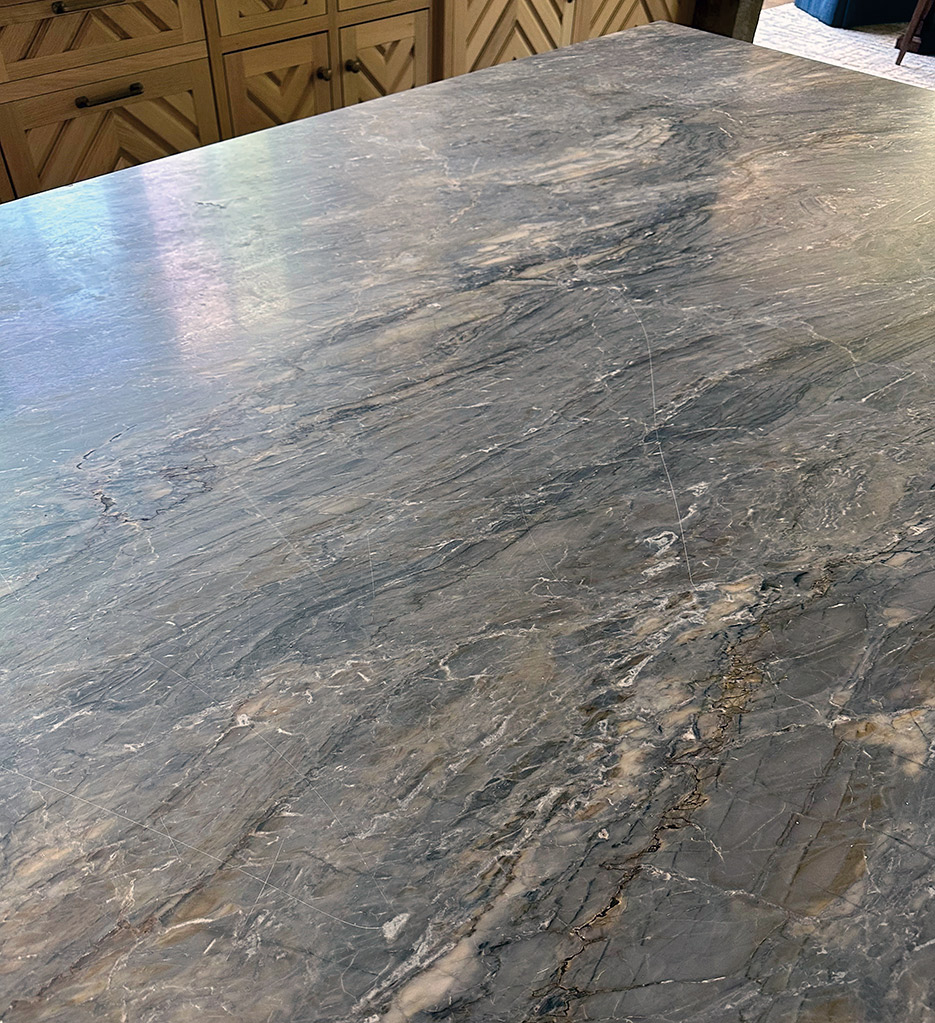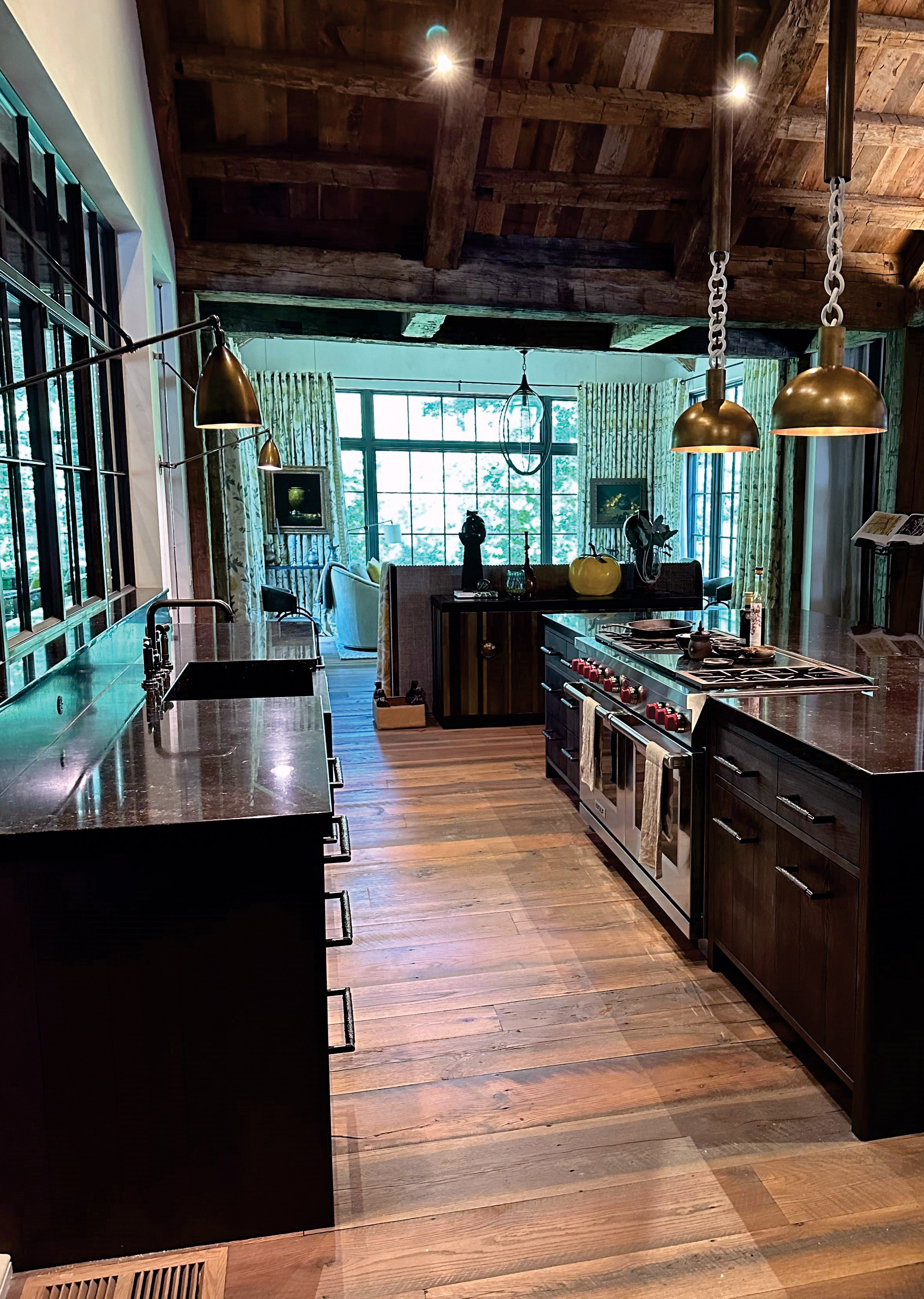Stone Restoration and Maintenance Corner –Honed Marble and Limestone Countertops
Bob Murrell
M3 Technologies
Photos by Bob Murrell
As we have discussed before, more and more honed countertops are becoming common in residential settings. This is especially true of marble and limestone counters. If you haven’t run into one yet, you will. This is actually a good thing, especially on calcium-based materials, as both etching and scratching don’t show up nearly as bad on honed surfaces as they do on polished surfaces. Honed surfaces are usually easier to maintain as well.
Just because a surface is honed doesn’t necessarily mean it won’t show etching and scratching, it just doesn’t usually show it as much. Of course there are different levels of hone, each with different appearance and reflective properties. A typical honed surface is normally between a 200 grit and 400 grit but there are levels both lower and higher in grit too. It depends on the particular material as to what grit level of hone both looks and performs best.
 |
|
Julie running a 200 grit ELF5 Flexible Metal-Bond 120 grit on the heavily scratched and etched areas. |
The higher in grit level the surface profile of a particular material is, the more vivid or bright the natural colors of the stone become. A naturally polished surface is the most color enhanced a material can be, even though added resins can add color. So, a happy median for a honed surface is, like I said, very commonly between a 200 grit and 400 grit surface profile level. I do run across higher levels of a honed surface, say 800 grit all the way to just below a polish. These will show more color and shine but also etching and scratching issues become much more noticeable than they would on a lower level of hone.
With a honed surface, the scratch pattern is part of the surface profile. A polished surface has very little to almost no surface profile, being almost monolithic. So the honed surface has more exposed surface area and therefore more exposed open and interstitial pores. With more exposed pores, the more likely the surface is to absorb staining materials, especially fats and oils. Therefore, honed surfaces will need protection in the form of an impregnating sealer, preferably an oleophobic (oil and grease resistant) type. The Majestic Low Odor Solvent-Based Impregnating Sealer, which does not produce an offensive smell, is very effective at stain resistance. Other quality brands like the Akemi line of products can also be effective. On lower levels of hone (say 200 grit and below), color enhancing impregnators can be used to bring out more of the stone’s natural color.
 |
|
Above: The scratching is so deep on this limestone countertop that you can catch it with your fingernail.
Below: Overall view of the damaged surface. Just because a surface is honed doesn’t mean it won’t show etching and scratching. |
 |
Even with the use of a quality impregnating sealer for stain prevention, etching can and will continue to occur. Impregnators penetrate the surface and help keep foreign liquid contaminants from entering the pore structure of the material. They will not prevent etching from acid etching on the surface. They will help keep the acid from penetrating, keeping the etch more so at the surface. This can make for easier etch repair going forward.
A couple of very high-end honed limestone and marble (really a metamorphic limestone) counters were recently refinished due to excessive etching and scratching, which had accumulated over the years. Remember, even with a good impregnator applied, these countertops will still etch and because of their hardness level (3-4 on the Mohs scale), they will scratch too.
On one countertop some of the scratching was deep (your fingernail could catch it), so the initial grind in these areas (where heavy scratching was present) was a 120 grit Flexible ELF series metal-bond, under a Makita variable speed polisher. Care was taken to keep the 5˝ discs flat, to avoid a leading-edge pattern and/or gouging. A 220 grit Flexible ELF was then used, and then feathered out a little more. Finally, a 200 grit PLP diamond impregnated pad (dip) was used to feather out and bring the surface to a consistent level of hone. The 200 grit PLP was used on the entire surface.
The next countertop was a much more compact material and had less deterioration than the previous project. Also, the client desired more of shine but not quite to a complete polish. This countertop was honed with a Flexible Metal Bond 400 grit and then a 1500 grit PLP Diamond Impregnated Pad. The high level of hone achieved, without a full polish, was outstanding.
Once the restoration of the countertops was completed, each was impregnated with Akemi Color Intensifier. This helped to enhance the natural color of each material. The Akemi Color Intensifier is also a good impregnator for improving stain resistance. I like this particular Akemi product as it tends to penetrate denser stones like these and give some color enhancement. The higher in grit the surface is taken to, the harder it is for a color enhancing impregnator to penetrate and therefore work like it should. Color enhancing impregnators are typically designed to work on surfaces with more surface area than a polished surface, like textured and low honed surfaces. This is especially true of denser materials. It did, however, work well on the high-honed dark countertop.
The two countertops were completely different stones but in the same calcium-based metamorphic class of materials. As you can see from the photos, each countertop turned out very nice. Clients were extremely satisfied. They also know that their stone surfaces will need periodic restoration to reverse any accumulated etching and scratching from routine use. This is a good trait of these surfaces, they are easy to restore. This type of project is what helps to give a restoration contractor repeat business, almost like a subscription service. This is a good thing, indeed.
 |
|
Above: Overall view of the damaged surface. Just because a surface is honed doesn’t mean it won’t show etching and scratching.
Below: The final high hone look on the island. Notice the Tape & Drape, masking, and portable wall for protecting the surrounding surfaces. |
 |
|
Below: Final results in this kitchen, after using the Akemi Color Intensifier. |
 |
As always and before beginning any new project, I recommend submitting a test area to confirm the results and the procedure, prior to starting a stone or hard surface restoration/maintenance project. Also, the best way to help ensure success is by partnering with a good distributor, like BB Industries, that knows the business. They can help with technical support, product purchase decisions, and other pertinent project information.
Bob Murrell has worked in the natural stone industry for over 40 years and is well known for his expertise in natural stone, tile, and decorative concrete restoration and maintenance. He helped develop some of the main products and processes which revolutionized the industry, and is currently the Director of Operations for M3 Technologies.
Send your comments and questions to Bob at attn: publisher@slipperyrockgazette.net .